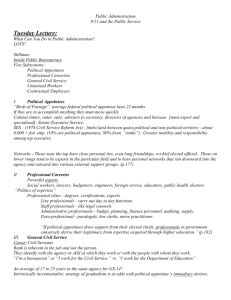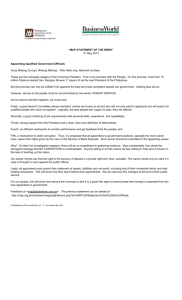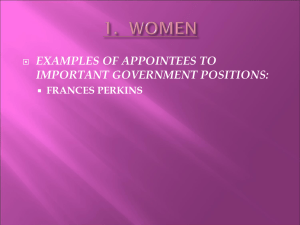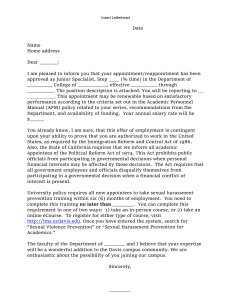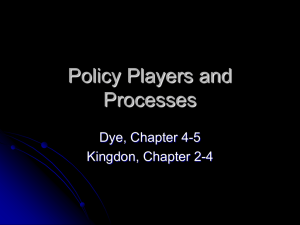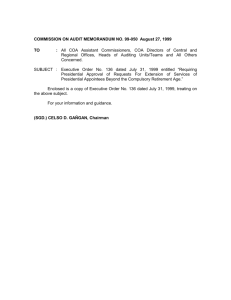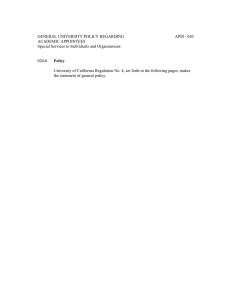Leadership Forum Summary Institute for the Study of Public Policy Implementation
advertisement
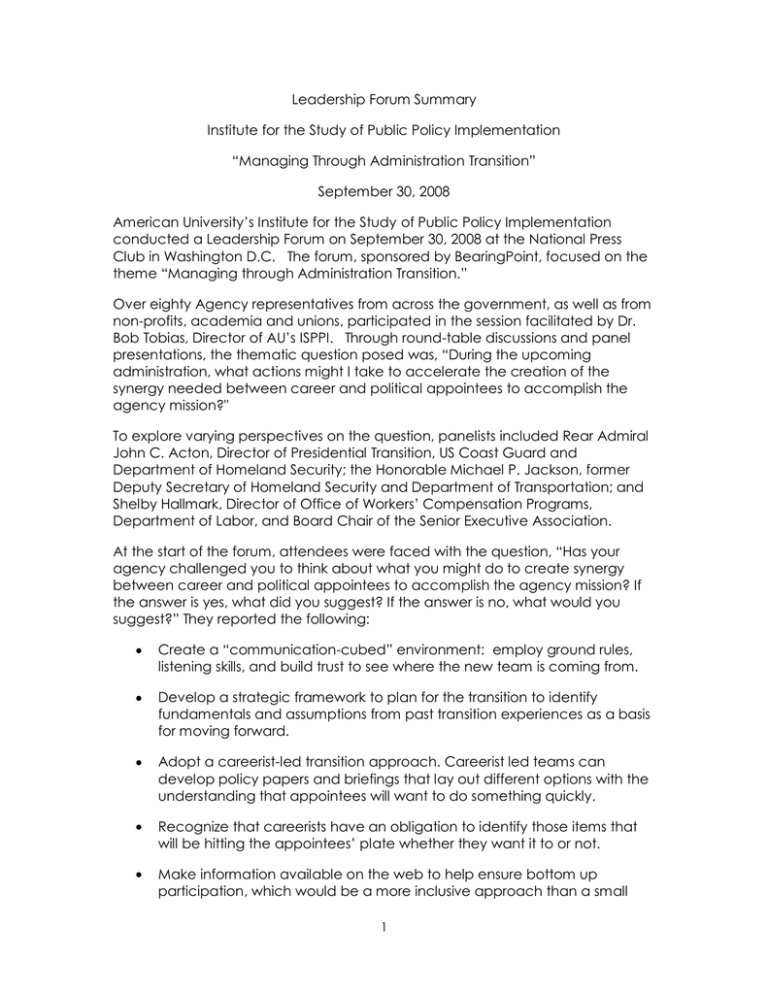
Leadership Forum Summary Institute for the Study of Public Policy Implementation ―Managing Through Administration Transition‖ September 30, 2008 American University‘s Institute for the Study of Public Policy Implementation conducted a Leadership Forum on September 30, 2008 at the National Press Club in Washington D.C. The forum, sponsored by BearingPoint, focused on the theme ―Managing through Administration Transition.‖ Over eighty Agency representatives from across the government, as well as from non-profits, academia and unions, participated in the session facilitated by Dr. Bob Tobias, Director of AU‘s ISPPI. Through round-table discussions and panel presentations, the thematic question posed was, ―During the upcoming administration, what actions might I take to accelerate the creation of the synergy needed between career and political appointees to accomplish the agency mission?" To explore varying perspectives on the question, panelists included Rear Admiral John C. Acton, Director of Presidential Transition, US Coast Guard and Department of Homeland Security; the Honorable Michael P. Jackson, former Deputy Secretary of Homeland Security and Department of Transportation; and Shelby Hallmark, Director of Office of Workers‘ Compensation Programs, Department of Labor, and Board Chair of the Senior Executive Association. At the start of the forum, attendees were faced with the question, ―Has your agency challenged you to think about what you might do to create synergy between career and political appointees to accomplish the agency mission? If the answer is yes, what did you suggest? If the answer is no, what would you suggest?‖ They reported the following: Create a ―communication-cubed‖ environment: employ ground rules, listening skills, and build trust to see where the new team is coming from. Develop a strategic framework to plan for the transition to identify fundamentals and assumptions from past transition experiences as a basis for moving forward. Adopt a careerist-led transition approach. Careerist led teams can develop policy papers and briefings that lay out different options with the understanding that appointees will want to do something quickly. Recognize that careerists have an obligation to identify those items that will be hitting the appointees‘ plate whether they want it to or not. Make information available on the web to help ensure bottom up participation, which would be a more inclusive approach than a small 1 group preparing a set of three ring binders for the political appointee. Encourage appointees to foster collaboration through a willingness to work and build trusted relationships with career employees, beyond just working with other political appointees. Create a gap analysis of current programs to those that are anticipated and include a range of options. The first presentation was from Admiral Acton, who spoke about transition efforts from the perspective of a military officer. He discussed the oath that civil servants, and in particular military officers take, to remain apolitical as they prepare the current status of policies and programs and project the trajectory of programs into the future. Part of the careerist‘s important role is to get incoming appointees and officers ―smart so they can govern.‖ To fulfill that role, careerists have to be willing to honestly consider that if they cannot live with the administration‘s policy, then leaving may be the right option. Additionally, civil servants can maintain credibility, Admiral Acton stated, by being honest, patient, flexible, supportive of new policies, listen (or, as they say in the Coast Guard, ―Squint with your ears‖), be accountable, and speak English – acronyms and jargon create a power inequality. In his current position, Admiral Acton is charged with managing the transition effort at DHS, which has been organized into four ―buckets‖: 1) Internal processes - nuts & bolts of current appointees‘ blackberries being returned, issuing new devices to new appointees, clearances, and the like; 2) Confirmation materials - briefing books, 30/60/90 day identification of important issues that will be faced by the appointee, and a classified appendix of briefing material; 3) Training and exercises - stakeholder collaboration to identify what is key for appointees to learn providing situational awareness particularly when collaborating outside the agency; 4) Strategic communications and outreach - most effective avenues to reach out to those affected to help move from campaign rhetoric to governing policies to get appointees and careerists on the same page. Michael P. Jackson spoke from the perspective of a seasoned, former political appointee. Jackson described the key characteristics needed for the new appointee as someone who can practice ―adrenaline management,‖ is persistent, has ―thick skin,‖ knows to scan the environment constantly, and someone who acknowledges the careerists‘ longevity. Each appointee is different, Jackson said, and got there by serving as a trusted advisor who either helped the president get elected or was good at governing or both. 2 Mr. Jackson portrayed the careerist‘s most important role for the appointee as that of a coach and teacher—a ―pillar.‖ During transition, the careerist can bring the appointee up to speed on the actual parameters of the job: Who are the stakeholders? What is the budget process? What is White House policy process for this particular spot? Who are the people within the department/agency/program that the appointee needs to know? He encouraged careerists to think about arranging a ―field trip‖ for the appointee to see firsthand those operating on the front line of the agency, and help appointees ―go find the people they need to know.‖ Mr. Jackson advised careerists to not only think about looking upward in the organization, but also to address the needs of staff across and down the organization during transition. Finally, Shelby Hallmark commented from his standpoint as a veteran member of the Senior Executive Service. He began by reminding participants that ―synergy‖ means ―creating a whole that is greater than the sum of its parts.‖ Moving through the transition period, he acknowledged, is challenging and sometimes requires what seem like ―miraculous‖ efforts to make it effective. But he also reminded participants, ―Every four years we have a chance to make a miracle happen, and that‘s what transition is all about.‖ Mr. Hallmark pointed out that transitions are the moment when the SES is needed the most because of the lack of knowledge of political appointees and the need to acquire that knowledge quickly. He said SES members have an obligation to be able to explain every aspect of their programs, including goals, objectives, stakeholders, achievement, barriers, etc. He also stated members of the SES have an obligation to be candid and give their best advice. He said those who are tempted to ―sugar coat‖ problems in an attempt to become part of the ―political‖ team make a mistake: ―Members of the SES and political appointees have different roles to play, and the SES must ‗tell it like it is.‘‖ He supported Mr. Jackson‘s suggestion that political appointees make an effort to know the career leaders, and he also pointed out the value of President Bush‘s meeting with the SES community early in his first administration as a best practice. Based on the ensuing question and answer period and discussion, the attendees identified actions they will take back to their respective offices: ―Since we will be doing more with less and there will be major changes, we must keep the momentum of service to the public going, while change is occurring. We should be preparing now, because we are the people who are going to deliver.‖ ―Encourage appointees to get out and meet the people who can make them successful, and as a careerist, take those opportunities to get to know the appointees. The connections are needed to humanize the briefing books.‖ 3 ―Use available resources like GAO. It has a government-wide perspective on transition on its website and can help put key issues in perspective for the new administration.‖ ‖Careerists have an obligation to be honest and competent. Focusing on the basics – mission, vision, and goals of the agency – has worked the best for me in the past.‖ ―Encourage executive level meeting between careerists and appointees to build trust quickly‖ ‖Follow the Janet Reno model when she introduced herself to all the employees, and encouraged all new political appointees to do what HAS worked.‖ ―Careerists at every level have an obligation to recognize the insecurity of those careerists we lead and to provide reassurance.‖ ―Constantly talk to those we lead about the ongoing transition process.‖ From American University‘s Institute for the Study of Public Policy Implementation, thank you for participating in this Leadership Forum and walking the talk of synergistic administration transition. Make sure that you sign up for the next forum at the end of October and let us know how you‘ve been able to implement these suggestions. We wish to thank BearingPoint for sponsoring this event. 4
